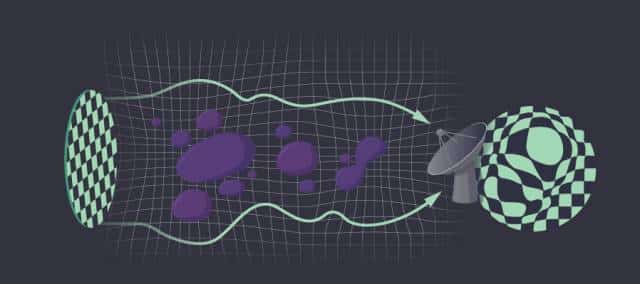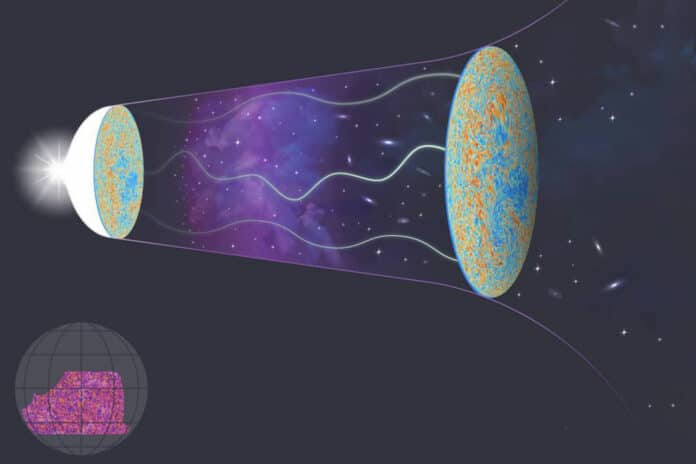Using light from the cosmic microwave background (CMB) as a backlight, scientists from the Atacama Cosmology Telescope (ACT) collaboration has created a new map of dark matter distributed across a quarter of the sky, extending deep into the cosmos. The study confirms Einstein’s theory of how massive structures grow and bend light over the 14-billion-year lifespan of the universe.
Scientists used CMB to outline all the matter between the Big Bang and us. The new image shows the invisible cosmic web of dark matter surrounding and connecting galaxies.
The experiment was initially proposed in 2003. At that time, scientists had yet to learn the full extent of information that could be extracted from the telescope. But, thanks to the cleverness of the theorists for building new instruments to make the telescope more sensitive and the latest analysis techniques.
Suzanne Staggs, director of ACT, and Henry DeWolf Smyth, Professor of Physics at Princeton University, said, “It’s a bit like silhouetting, but instead of just having black in the silhouette, you have texture and lumps of dark matter as if the light were streaming through a fabric curtain that had lots of knots and bumps in it. The famous blue and yellow CMB image [from 2003] is a snapshot of what the universe was like in a single epoch, about 13 billion years ago, and now this is giving us the information about all the epochs since.”
Jo Dunkley, a professor of physics and astrophysical sciences who leads the analysis for ACT, said, “It’s a thrill to be able to see the invisible, to uncover this scaffold of dark matter that holds our visible star-filled galaxies.”

Co-author Blake Sherwin, a 2013 Ph.D. alumnus of Princeton and a professor of cosmology at the University of Cambridge, where he leads a large group of ACT researchers, said, “Remarkably, 80% of the mass in the universe is invisible. By mapping the dark matter distribution across the sky to the largest distances, our ACT lensing measurements allow us to see this invisible world.”
The scientists studied how huge dark matter structures’ gravitational attraction can warp the CMB over its 14 billion-year voyage to Earth, much to how old, crinkly windows can bend and distort what we can see through them.
Mathew Madhavacheril, a 2016-2018 Princeton postdoc who is the lead author of one of the papers, said, “We’ve made a new mass map using distortions of light left over from the Big Bang. Remarkably, it provides measurements that show that both the lumpiness of the universe and the rate at which it is growing after 14 billion years of evolution are just what you’d expect from our standard model of cosmology based on Einstein’s theory of gravity.”
Sherwin added, “Our results also provide new insights into an ongoing debate some have called ‘The Crisis in Cosmology.'” This “crisis” stems from recent measurements that use a different background light emitted from stars in galaxies rather than the CMB. These have produced results that suggest the dark matter was not lumpy enough under the standard model of cosmology and led to concerns that the model may be broken. However, the ACT team’s latest results precisely assessed that the vast lumps seen in this image are the exact right size.”
Frank Qu, lead author of one of the papers and a Cambridge graduate student and a former Princeton visiting researcher, said, “While earlier studies pointed to cracks in the standard cosmological model, our findings provide new reassurance that our fundamental theory of the universe holds.”
Staggs said, “The CMB is famous already for its unparalleled measurements of the primordial state of the universe, so these lensing maps, describing its subsequent evolution, are almost an embarrassment of riches. Instead of a ‘crisis,’ we have an extraordinary opportunity to use these different data sets together.”
“Our map includes all of the dark matter, going back to the Big Bang, and the other maps look back about 9 billion years, giving us a layer that is much closer to us. We can compare the two to learn about the growth of structures in the universe. It is going to turn out to be interesting. That the two approaches are getting different measurements is fascinating.”
Scientists have submitted a set of papers to The Astrophysical Journal.
